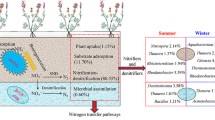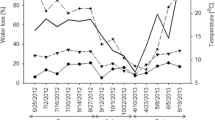Abstract
As a significant oxygen intensified configuration, tidal flow constructed wetlands (TFCWs) are effective for the treatment of water and wastewater rich in NH4+-N. The TFCWs filled with four substrates (gravel, granular active carbon, volcanic rock, and zeolite) were used to treat synthetic groundwater containing NH4+-N. The results showed that higher ammonium removal was achieved in TFCW filled with zeolite (89.20 ± 3.09%) and granular active carbon (53.70 ± 8.91%). The highest accumulation of nitrate was obtained in TFCW filled with volcanic rock, whereas the lowest was obtained in TFCW filled with granular active carbon. The quantitative polymerase chain reactions (qPCR) and high-throughput sequencing of bacterial 16S rRNA pyrosequencing were applied to reveal the involved microbial N removal pathways. The abundance of amoA gene of Nitrospira and anammox gene of unclassified Planctomycetaceae suggested anammox could play a key role in NH4+-N removal in the absence of organic carbon in the simulated groundwater. Besides, the results of adsorption isotherms showed that substrate adsorption coupled with anaerobic ammonium oxidation (anammox) were the major reason for the robust NH4+-N removal performance in TFCW filled with zeolite.






Similar content being viewed by others
Data Availability
The datasets generated during and/or analyzed during the current study are available from the corresponding author on reasonable request.
References
Bezbaruah, A. N., & Zhang, T. C. (2004). pH, Redox, and oxygen microprofiles in rhizosphere of bulrush (Scirpus validus) in a constructed wetland treating municipal wastewater. Biotechnology and Bioengineering, 88, 60–70.
Braeckevelt, M., Mirschel, G., Wiessner, A., Rueckert, M., Reiche, N., Vogt, C., et al. (2008). Treatment of chlorobenzene-contaminated groundwater in a pilot-scale constructed wetland. Ecological Engineering, 33, 45–53.
Brandt KK Hesselso/e M Roslev P Henriksen K So/rensen J. Toxic effects of linear alkylbenzene sulfonate on metabolic activity, growth rate, and microcolony formation of Nitrosomonas and Nitrosospira strains. (2001). Applied and Environmental Microbiology 67: 2489–2498
Chang, J., Mei, J., Jia, W., Chen, J., Li, X., Ji, B., et al. (2019). Treatment of heavily polluted river water by tidal-operated biofilters with organic/inorganic media: Evaluation of performance and bacterial community. Bioresource Technology, 279, 34–42.
Chung, Y. W., Kim, J., & Kong, S.-H. (2011). Performance prediction of permeable reactive barriers by three-dimensional groundwater flow simulation. International Journal of Environmental Science and Development, 2, 138.
Ding, Y., Wang, W., Song, X.-s, & Wang, Y.-h. (2014). Spatial distribution characteristics of environmental parameters and nitrogenous compounds in horizontal subsurface flow constructed wetland treating high nitrogen-content wastewater. Ecological Engineering, 70, 446–449.
Gagnon, V., Chazarenc, F., Comeau, Y., & Brisson, J. (2007). Influence of macrophyte species on microbial density and activity in constructed wetlands. Water Science and Technology, 56, 249–254.
Ge, S., Wang, S., Yang, X., Qiu, S., Li, B., & Peng, Y. (2015). Detection of nitrifiers and evaluation of partial nitrification for wastewater treatment: A review. Chemosphere, 140, 85–98.
Gonzalo, O. G., Ruiz, I., & Soto, M. (2017). Integrating pretreatment and denitrification in constructed wetland systems. Science of the Total Environment, 584, 1300–1309.
Guo, Z., Kang, Y., Hu, Z., Liang, S., **e, H., Ngo, H. H., et al. (2020). Removal pathways of benzofluoranthene in a constructed wetland amended with metallic ions embedded carbon. Bioresource Technology, 311, 123481.
Han, Z., Dong, J., Shen, Z., Mou, R., Zhou, Y., Chen, X., et al. (2019). Nitrogen removal of anaerobically digested swine wastewater by pilot-scale tidal flow constructed wetland based on in-situ biological regeneration of zeolite. Chemosphere, 217, 364–373.
Hao, X., Wang, D., Wang, P., Wang, Y., & Zhou, D. (2016). Evaluation of water quality in surface water and shallow groundwater: A case study of a rare earth mining area in southern Jiangxi Province, China. Environmental Monitoring & Assessment, 188, 1–11.
Hu, Y., He, F., Ma, L., Zhang, Y., & Wu, Z. (2016). Microbial nitrogen removal pathways in integrated vertical-flow constructed wetland systems. Bioresource Technology, 207, 339–345.
Hu, X., Su, J., Ali, A., Wang, Z., & Wu, Z. (2021). Heterotrophic nitrification and biomineralization potential of Pseudomonas sp. HXF1 for the simultaneous removal of ammonia nitrogen and fluoride from groundwater. Bioresource Technology, 323, 124608.
Jetten, M. S., Lv, Niftrik, Strous, M., Kartal, B., Keltjens, J. T., & Op den Camp, H. J. (2009). Biochemistry and molecular biology of anammox bacteria. Critical Reviews in Biochemistry and Molecular Biology, 44, 65–84.
Jia, X., O’Connor, D., Hou, D., **, Y., Li, G., Zheng, C., et al. (2019). Groundwater depletion and contamination: Spatial distribution of groundwater resources sustainability in China. Science of the Total Environment, 672, 551–562.
Jia, L., Liu, H., Kong, Q., Li, M., Wu, S., & Wu, H. (2020). Interactions of high-rate nitrate reduction and heavy metal mitigation in iron-carbon-based constructed wetlands for purifying contaminated groundwater. Water Research, 169, 115285.
Kizito, S., Lv, T., Wu, S., Ajmal, Z., Luo, H., & Dong, R. (2017). Treatment of anaerobic digested effluent in biochar-packed vertical flow constructed wetland columns: Role of media and tidal operation. Science of the Total Environment, 592, 197–205.
Li, D., Zhou, Y., Long, Q., Li, R., & Lu, C. (2020). Ammonia nitrogen adsorption by different aquifer media: An experimental trial for nitrogen removal from groundwater. Human and Ecological Risk Assessment: An International Journal, 26, 2434–2446.
Liu T Lo I. Influences of Humic Acid on Cr(VI) 2011 Removal by zero-valent iron from groundwater with various constituents: Implication for long-term PRB performance. Water, Air, & Soil Pollution, 216(1-4): 473-483.
Liu, M., Wu, S., Chen, L., & Dong, R. (2014). How substrate influences nitrogen transformations in tidal flow constructed wetlands treating high ammonium wastewater? Ecological Engineering, 73, 478–486.
Liu, H., Hu, Z., Zhang, J., Ngo, H. H., Guo, W., Liang, S., et al. (2016). Optimizations on supply and distribution of dissolved oxygen in constructed wetlands: A review. Bioresource Technology, 214, 797–805.
Maharjan AK, Mori K, Toyama T. 2020 Nitrogen removal ability and characteristics of the laboratory-scale tidal flow constructed wetlands for treating ammonium-nitrogen contaminated groundwater. Water, 12.
Maltais-Landry, G., Maranger, R., Brisson, J., & Chazarenc, F. (2009). Nitrogen transformations and retention in planted and artificially aerated constructed wetlands. Water Research, 43, 535–545.
Mao, X., **ong, L., Hu, X., Yan, Z., Wang, L., & Xu, G. (2018). Remediation of ammonia-contaminated groundwater in landfill sites with electrochemical reactive barriers: A bench scale study. Waste Management, 78, 69–78.
Martinez-Espinosa, C., Sauvage, S., Al Bitar, A., Green, P. A., Vorosmarty, C. J., & Sanchez-Perez, J. M. (2021). Denitrification in wetlands: A review towards a quantification at global scale. Science of The Total Environment, 754, 142398.
Mojiri, A., Ziyang, L., Tajuddin, R. M., Farraji, H., & Alifar, N. (2016). Co-treatment of landfill leachate and municipal wastewater using the ZELIAC/zeolite constructed wetland system. Journal of Environmental Management, 166, 124–130.
Obiri-Nyarko, F., Grajales-Mesa, S. J., & Malina, G. (2014). An overview of permeable reactive barriers for in situ sustainable groundwater remediation. Chemosphere, 111, 243–259.
Parker DS. 1975 Process design manual for nitrogen control.
Raboni, M., Torretta, V., Viotti, P., & Urbini, G. (2013). Experimental plant for the physical-chemical treatment of groundwater polluted by municipal solid waste (MSW) leachate, with ammonia recovery. Revista Ambiente & Agua, 8, 22–32.
Saeed, T., Miah, M. J., Khan, T., & Ove, A. (2020). Pollutant removal employing tidal flow constructed wetlands: Media and feeding strategies. Chemical Engineering Journal, 382, 122874.
Seeger, E. M., Kuschk, P., Fazekas, H., Grathwohl, P., & Kaestner, M. (2011). Bioremediation of benzene-, MTBE-and ammonia-contaminated groundwater with pilot-scale constructed wetlands. Environmental Pollution, 159, 3769–3776.
Shammas NK. 1986 Interactions of temperature, pH, and biomass on the nitrification process. Journal Water Pollution Control Federation, 52–59.
Stefanakis, A. I., & Tsihrintzis, V. A. (2012). Effects of loading, resting period, temperature, porous media, vegetation and aeration on performance of pilot-scale vertical flow constructed wetlands. Chemical Engineering Journal, 181, 416–430.
Tan, X., Yang, Y., Liu, Y., Li, X., Fan, X., Zhou, Z., et al. (2019). Enhanced simultaneous organics and nutrients removal in tidal flow constructed wetland using activated alumina as substrate treating domestic wastewater. Bioresource Technology, 280, 441–446.
Vymazal, J. (2007). Removal of nutrients in various types of constructed wetlands. Science of the Total Environment, 380, 48–65.
Wang, L., & Li, T. (2014). Vegetation effects on anammox spatial distribution and nitrogen removal in constructed wetlands treated with domestic sewage. Water Science and Technology, 70, 1370–1375.
Wang, Z., Huang, M., Qi, R., & Zhang, Y. (2017). Enhancing nitrogen removal via the complete autotrophic nitrogen removal over nitrite process in a modified single-stage tidal flow constructed wetland. Ecological Engineering, 103, 170–179.
Wang, H., Xu, J., & Sheng, L. (2020). Purification mechanism of sewage from constructed wetlands with zeolite substrates: A review. Journal of Cleaner Production, 258, 120760.
Wang, Y., Cai, Z., Sheng, S., Pan, F., Chen, F., & Fu, J. (2020). Comprehensive evaluation of substrate materials for contaminants removal in constructed wetlands. Science of The Total Environment, 701, 134736.
Wang, Z., Zhao, X., **e, T., Wen, N., & Yao, J. A. (2021). comprehensive evaluation model of ammonia pollution trends in a groundwater source area along a river in residential areas. Water, 13, 1924.
Xu, D., **ao, E., Xu, P., Zhou, Y., He, F., Zhou, Q., et al. (2017). Performance and microbial communities of completely autotrophic denitrification in a bioelectrochemically-assisted constructed wetland system for nitrate removal. Bioresource Technology, 228, 39–46.
Yuan, C., Zhao, F., Zhao, X., & Zhao, Y. (2020). Woodchips as sustained-release carbon source to enhance the nitrogen transformation of low C/N wastewater in a baffle subsurface flow constructed wetland. Chemical Engineering Journal, 392, 124840.
Zhan, X., Yang, Y., Chen, F., Wu, S., & Zhu, R. (2020). Treatment of secondary effluent by a novel tidal-integrated vertical flow constructed wetland using raw sewage as a carbon source: Contribution of partial denitrification-anammox. Chemical Engineering Journal, 395, 125165.
Zhang, Y., Wu, J., & Xu, B. (2018). Human health risk assessment of groundwater nitrogen pollution in **ghui canal irrigation area of the loess region, northwest China. Environmental Earth Sciences, 77, 1–12.
Zhang, W., Bai, Y., Ruan, X., & Yin, L. (2019). The biological denitrification coupled with chemical reduction for groundwater nitrate remediation via using SCCMs as carbon source. Chemosphere, 234, 89–97.
Zhang M, Huang J-C, Sun S, Rehman MMU, He S. 2020 Molecular and stable isotopic evidence for anaerobic ammonium-oxidizing bacteria in tidal flow constructed wetlands. International Biodeterioration & Biodegradation, 149.
Zhi, W., & Ji, G. (2014). Quantitative response relationships between nitrogen transformation rates and nitrogen functional genes in a tidal flow constructed wetland under C/N ratio constraints. Water Research, 64, 32–41.
Zhi, W., Yuan, L., Ji, G., & He, C. (2015). Enhanced long-term nitrogen removal and its quantitative molecular mechanism in tidal flow constructed wetlands. Environmental Science and Technollogy, 49, 4575–4583.
Zhou X, Chen Z, Li Z, Wu H. 2020 Impacts of aeration and biochar addition on extracellular polymeric substances and microbial communities in constructed wetlands for low C/N wastewater treatment: Implications for clogging. Chemical Engineering Journal, 396.
Zhuang, L.-L., Yang, T., Zhang, J., & Li, X. (2019). The configuration, purification effect and mechanism of intensified constructed wetland for wastewater treatment from the aspect of nitrogen removal: A review. Bioresource Technology, 293, 122086.
Funding
This research was supported financially by the Natural Science Foundation of Jiangxi Province, China (20192BAB213021), and the Key Promotion Project of Science and Technology Achievements of Jiangxi Provincial Water Resources Department (202123TGKT06), and the Key Research and Development Program of Jiangxi Province (CN) (20202BBGL73086, 20201BBG71012).
Author information
Authors and Affiliations
Corresponding author
Ethics declarations
Conflict of Interest
The authors declare no competing interests.
Additional information
Publisher's Note
Springer Nature remains neutral with regard to jurisdictional claims in published maps and institutional affiliations.
Rights and permissions
About this article
Cite this article
Xu, D., Ling, H., Li, Z. et al. Treatment of Ammonium-Nitrogen–Contaminated Groundwater by Tidal Flow Constructed Wetlands Using Different Substrates: Evaluation of Performance and Microbial Nitrogen Removal Pathways. Water Air Soil Pollut 233, 159 (2022). https://doi.org/10.1007/s11270-022-05633-6
Received:
Accepted:
Published:
DOI: https://doi.org/10.1007/s11270-022-05633-6




